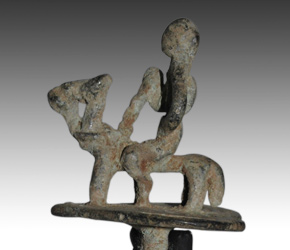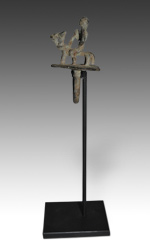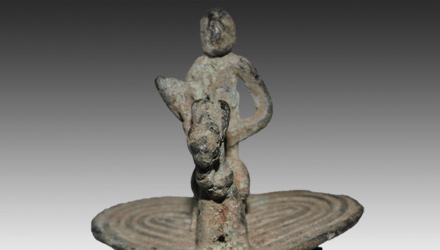Djenne Bronze Ring with Horse & Rider
 |
|
"Djenne retained a reputation as an artistic center producing meaningful adornment and ritual objects for its inhabitants and those of surrounding areas. This ring undoubtedly depicts a wealthy and important man, as historically, horses did not flourish in Djenne and had to be imported at great expense from the Arab world."
Djenne is a town in the inland Niger Delta region of Mali. At the height of its popularity it had a population somewhere around 10,000. Djenne is often referred to interchangeably as both a city and people; and it is safe to say the Djenné were the first and probably most important of the inland Niger Delta civilizations to be discovered by the west. The city was originally founded around 800 A.D. Later, it became an important Islamic cultural center as well as a center of trans-Saharan trade, which included goods such as salt, gold and slaves.
 |
|
|
|
Djenne shared its fortunes with Timbuktu, as trade goods passing in and out of Timbuktu also passed through Djenne. Unfortunately, for both towns, in the early 15th century the Portuguese established trading centers on the African coast. Ultimately, the importance of trans-Saharan trade declined and with it the fortunes of both Djenne and Timbuktu.
Although both cities became centers of Muslim scholarship, Djenne retained a reputation as an artistic center producing meaningful adornment and ritual objects for its inhabitants and those of surrounding areas. This ring undoubtedly depicts a wealthy and important man, as historically, horses did not flourish in Djenne and had to be imported at great expense from the Arab world. The importation of horses began around 1000 A.D. They arrived along with Islamic thought. However, they soon became prestigious possessions, associated with power and wealth; and adornment, such as this ring became conspicuous symbols of rank.
This piece was crafted using lost wax methodology, which most likely made its way to western, sub-Saharan Africa from the Arab world, just like horses and Islamic beliefs. It is equally likely the owner of the ring was not a convert to Islam because of the prohibition on figurative art. It could very well be, albeit conjecture, that the owner of this piece was a trader or merchant of some sort, perhaps someone engaged in the remnants of the trans-Saharan trade, which persisted because of small population centers servicing the indigenous, tribal populations of the region.

|
|
Download this Article: Djenne Iron Ring with Horse & Rider.pdf